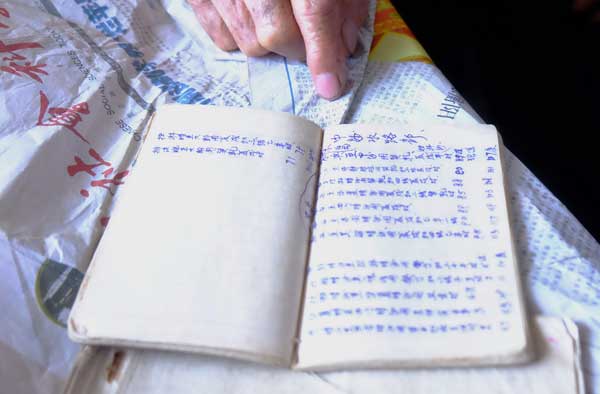Editor's note: China Daily is running a series of articles on the South China Sea. The articles cover a range of topics and provide an insight into what life is like on South China Sea islands. The reporters also examine the long-established Chinese sovereignty over the islands.

Su Chengfen has spent all his life fishing in the reef-filled South China Sea, guided by a handwritten book more than 600 years old that depicts routes to various remote islands from Hainan province.
The former fishing vessel captain, who lives in the town of Tanmen, cherishes the book, wrapping it in layers of paper even though at 81 it is impossible for him to return to the sea.
He has always known it is precious, as it contains detailed information handed down over the generations, but at first he had not realized its true significance.
Specialists say the information the book contains is undeniable proof of China's sovereignty over Huangyan Island.
"Unlike other versions, it depicts the exact route to Huangyan Island. It clearly proves that generations of Chinese fishermen have worked on the island," said Zhou Weimin, a retired professor at Hainan University.
Zhou wrote An Arcane Book About the South China Sea, the first book in China studying genglubu, a term used for various editions of ancient handwritten books recording sailing routes in the South China Sea. Zhou's book was published last year.
Gao Zhiguo, director of the China Institute for Marine Development Strategy, who used to serve as a judge on the International Tribunal for the Law of the Sea, said, "One book on genglubu beats a thousand words.
"It is ironclad proof. ... We can deduce China's historic fishing and sailing rights in the South China Sea, as well as ownership."
Su inherited the book from his father when he became a boat captain at 23. He said his father was given the book by his grandfather.
"I relied on it for many years until I got a modern map of the South China Sea in 1985," he said.
The book is not easy to understand or decipher, as it uses archaic words and ancient expressions for directions. But once the "code" is cracked, its accuracy is unquestionable.
Fu Shibao, an officer at the border police station in Tanmen, said there used to be at least 1,000 such books in the seafaring town.
"Now there are only about a dozen books left," said Fu, who has been helping Hainan University to study and protect the remaining books. He said the true value of the books was realized after friction between China and the Philippines over Huangyan Island escalated sharply in 2012.
Zhou, who has studied genglubu for 26 years with his wife, said that a book provided by former sea captain Peng Zhengkai records 17 routes to the Xisha Islands and more than 200 routes to the Nansha Islands. This book also contains many other details, including the weather conditions and ocean currents for every month.
Fishermen in ancient times named 136 islands and reefs in the books for China, much earlier than they were named by other countries, Zhou said.
Many of the names are still used, and nine of them have become official names in English. The Paracel Islands, for example, are named from a Portuguese word meaning "stone reef", which originally comes from the Chinese.
There are 287 named locations in the South China Sea. Zhou said the ancient Chinese did not name the others because many of them are submerged or partly submerged banks.
Genglubu date to the Ming Dynasty (1368-1644), he said, adding, "We are the earliest owners of the South China Sea."
He said the routes, along with China's historical documents, archaeological discoveries and accounts from old seafarers and fishermen show that "waters around the Dongsha, Xisha, Zhongsha and Nansha islands had become fixed fishing grounds for Chinese fishermen in the Ming Dynasty".


















































